Nixeus VUE 30: 30" 2560x1600 IPS Monitor Review
by Chris Heinonen on August 20, 2013 6:00 AM ESTTested using the Leo Bodnar lag tester, I measured 29.23ms of lag with a 1080p signal on the VUE 30. TO use the Leo Bodnar I average the three areas of the screen; top, middle, and bottom, that it can provide data for. With the VUE 30 the Top and Middle were both really low, at 21.6ms and 27.5ms, but it jumped up to 38.6ms at the bottom. I usually see variations of around 7-8ms between the areas, or roughly half the 16.7ms it takes to move between frames, but not a spread of 6ms and then 11ms.
Despite that weird measurement, I didn’t see any tearing or anything else that might be an issue when using the Nixeus for gaming. I’ll just chalk it up to some slightly strange behavior with the scaler and its timing, but not something that I could actually see a problem with. Note also that lag might be lower running at the native 2560x1600, but I can't directly compare that with most other displays as they lack support for that resolution.
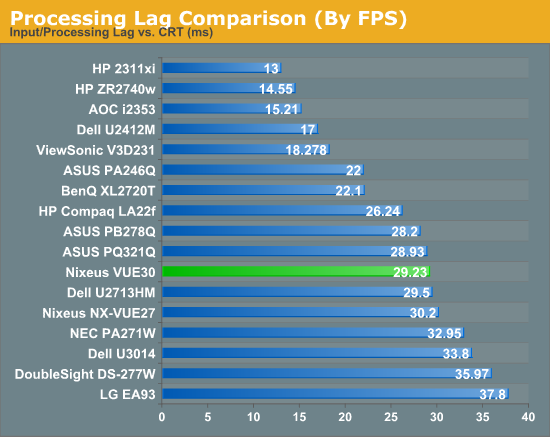
Power use is not a good area for the Nixeus. It is rated for < 130 watts of power consumption on the specs, but my unit managed to use over 150 watts at peak brightness. Since the peak brightness was also almost 75 cd/m2 below the specs, that is a large difference there in the power measurements. A white screen also uses less energy than a black screen with an LCD typically, so I’m not sure what would provide a power measurement that low while running at maximum brightness. Most likely Nixeus is rating power use by how much the display requires and not accounting for the efficiency of the power brick; 85% efficiency at 130W would give us 153W, which is close to what I'm seeing, but it's still quite a bit higher than a modern LED backlit display.
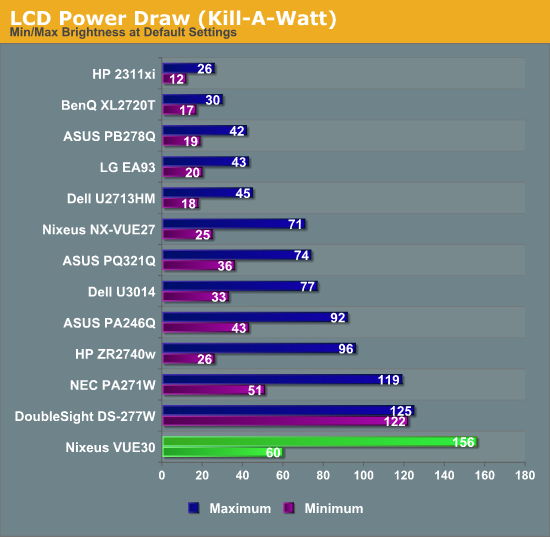
Going down to minimum brightness drops the power use to 60 watts, which is much more reasonable. Using my formula to get candelas per square inch per watt, the Nixeus came in dead last among the displays I have tested. All of the 30” displays do poorly here, as their more complex backlighting systems use a lot more power, but the Nixeus is the worst offender.
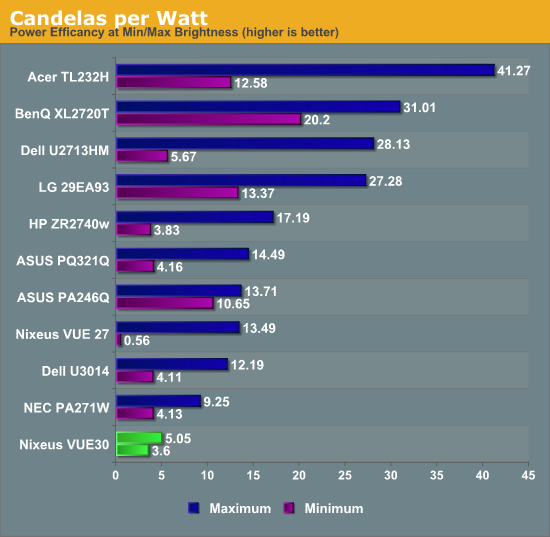
Running the Nixeus profile through Gamutvision, we see 103% coverage of the AdobeRGB gamut. This falls short of some other displays, but still is full coverage and as we saw it works pretty well when in AdobeRGB mode.
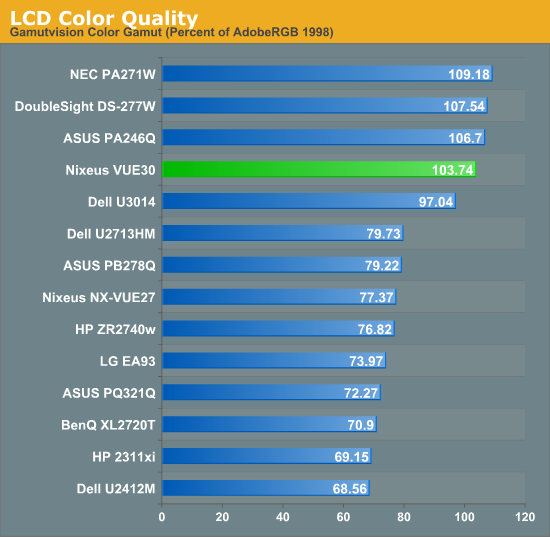
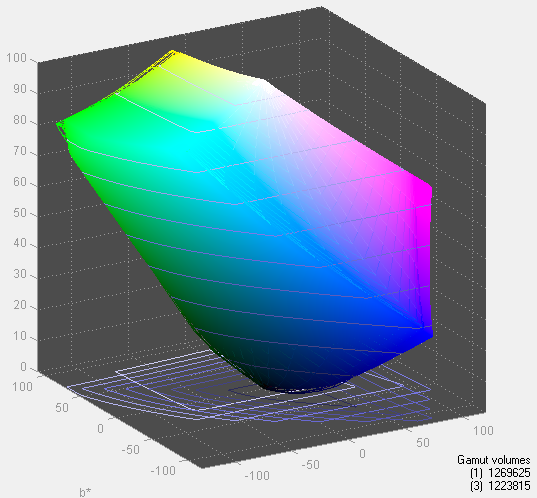


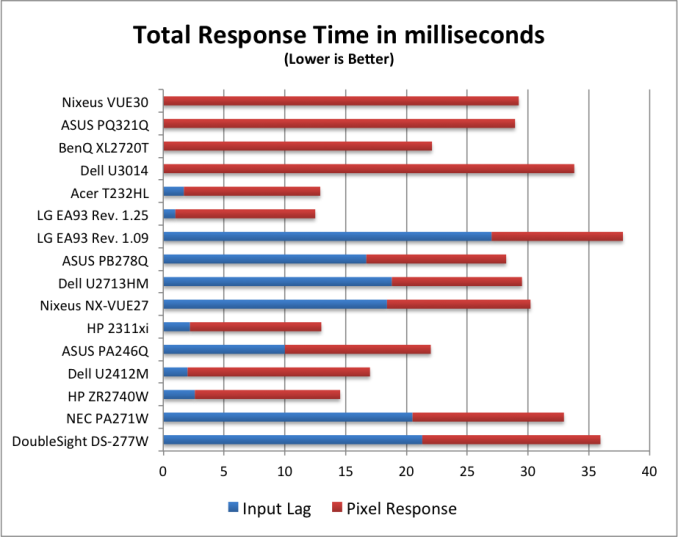








95 Comments
View All Comments
blackoctagon - Tuesday, August 20, 2013 - link
Glad to hear you're so insensitive to input lag. However, what you experience is by no means the cream of the crop. One can maintain the pleasant colours of IPS and still have good motion clarity by getting one of the overclockable 27-inch 1440p screens. Their input lag is much less, and further mitigated by the (approx.) 120Hz refresh rate. Orders of magnitude better for FPS gaming than what a 30-inch IPS screen can deliverDanNeely - Tuesday, August 20, 2013 - link
The 2408 was infamously bad. Unlike previous laggy Dell panels that only bothered some gamers the 2408 was slow enough that it annoyed a lot of people who were just working at the desktop. While continuing to insist nothing was wrong and it was working as designed; Dell/etc pulled back (and eventually started listing it on their spec sheets) and the display industry generally insisted on nothing slower than ~2 frames (32ms) which are good enough that no one other than some action gamers complain. I occasionally notice what might be the 30ms on my NEC 3090 when playing POE (an aRPG); but it's intermittent enough I'm not sure if it's actually panel lag or just me hitting the limits of my reaction time.ZeDestructor - Tuesday, August 20, 2013 - link
>overclockable 27-inch 1440p screensRPS or bit-tech (can't remember which) tested that when the Titan came out. They only achieved ~72Hz before the panel itself just started dropping frames because it couldn't keep up.
Besides, as I said up there, image processing and DP->LVDS conversion takes time. constant time, but time nonetheless. If you had a TN panel at 2560x1600@60Hz, you'd see at least 12ms of processing lag + some more for the panel itself. If you can rip out the on-board processing entirely, you're reducing the lag quite a a bit, which is exactly what game modes do: pipe the signal straight to LVDS conversion with no post-processing. On the U2410, that drops the latency from ~30ms to ~14ms.
In any case, you missed the point of my comment, where I mentioned it being in the same range as most other wide-gamut, professional-use panels and perfectly fine for single-player gaming, where you can learn to compensate for it. Hell, my LoL-playing friends used to pull off skillshots by timing it just right with a a 300ms ping time to US servers. If you think 30ms is bad...
blackoctagon - Tuesday, August 27, 2013 - link
I would like to see this "RPS or bit-tech" review if you can find it. There are plenty of 2560x1440 monitors out there that overclock SLIGHTLY, but VERY few that support refresh rates up to approx. 120Hz. Unless the reviewers looked at one of the latter monitors (which would surprise me) then I'm not surprised that they started seeing dropped frames.davsp - Tuesday, August 20, 2013 - link
Viewable Size = 20" I'm guessing typo on spec sheet. :)ingwe - Tuesday, August 20, 2013 - link
Nah, didn't you see the HUGE bezel?ZeDestructor - Tuesday, August 20, 2013 - link
> Note also that lag might be lower running at the native 2560x1600, but I can't directly compare that with most other displays as they lack support for that resolution.Please don't do that. People who buy/want these big, 30" 16:10 panels are paying the hefty premium for the full resolution, not to run something lower through the scaler. As such, I (and others, probably) would appreciate native resolution response times rather than scaled. 2560x1600 is uncommon because of the hefty price (1.5k per screen so far!), not because wqe don't want 2560x1600.
JarredWalton - Tuesday, August 20, 2013 - link
I believe Chris is using a Leo Bodnar device now (http://bit.ly/WXV7Vv), where formerly he used a CRT as a reference display sending the same content to both. To do native 2560x1600 lag tests, you'd need a device (CRT or Leo Bodnar or similar) that supports WQXGA...which doesn't exist. Chris can correct me if I'm wrong, though.saratoga3 - Tuesday, August 20, 2013 - link
Apparently that device can't do > 1080p. Unfortunately this means using the scaler, which I think is a really bad idea. Resizing a 4 MP image can easily take an entire frame worth of latency. Its entirely possible that the actual input lag at native resolution is much lower.mdrejhon - Wednesday, August 21, 2013 - link
The Blur Busters Input Lag Tester, supports 4K, 120Hz, WQXGA and any other resolutions. It will be released before the end of the year. There is also a second input lag tester (SMTT style) that I have invented as well, which is undergoing tests. Keep tuned at the Blur Busters website.